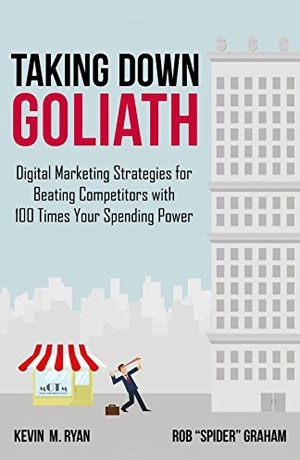 Learn the
rules before breaking them -- and don't forget that basic online advertising and marketing skills provide the platform that leads marketers to success. Make a contribution to the world and the
world will make one back. It's not easy. In fact, technology makes it more complicated, mathematically challenging, and confusing -- especially search engine marketing, which offers the least
amount of overall control, yet yields the highest measurable returns.
Learn the
rules before breaking them -- and don't forget that basic online advertising and marketing skills provide the platform that leads marketers to success. Make a contribution to the world and the
world will make one back. It's not easy. In fact, technology makes it more complicated, mathematically challenging, and confusing -- especially search engine marketing, which offers the least
amount of overall control, yet yields the highest measurable returns.
Taking Down
Goliath demonstrates how middle-tier companies can compete with brands wielding 100 times the spending power, offering alternative views to best practices for search, display, social,
and other media. More than one hundred and ninety-six pages of words, minus the Appendix and Index, deliver simple, yet powerful messages for digital marketers who want to learn more about competing
in the digital world.
advertisement
advertisement
Although it's not the end all, be all book, Taking Down Goliath offers a twist on familiar concepts. Kevin Ryan and Rob Spider Graham provide guidance for
managing digital campaigns across media. The text profiles strategies and tactics needed to navigate digital marketing and explain each marketing discipline in detail.
Find the emotional
trigger. Most people want to feel good about them. Offers must convey a sense of well being. Consumers want to believe the products and services they buy will help them achieve their goal.
triggers allow people to sense something. The messages are often delivered subconsciously but still trigger consumers' emotions. Each trigger touches a core human need, by seeking pleasure and
avoiding pain.
Don't make assumptions. Reaching the correct people and getting their attention with the perfect message matters most. It's called fair value exchange, and the goal is to
attract consumers' attention by giving them a fair value exchange -- their attention in exchange for what the publisher or advertisers offer, per the authors.
Pick up the conversation where
you left off -- don't start a new conversation each time you meet the same person on your Web site. It may seem simple, but the authors make an interesting analogy to prove a point. The guests arrive
at a party and start a conversation. They shares basic information about themselves, such as their name, where they live and occupation as they look for common points of interest. It's a party, so
partygoers mingle with other guests. An hour later they bump into each other again by the bar. They don't restart the new conversation by asking each other's name and address. Instead, they move the
conversation to the next topic.
Another rule that is often overlooked is to measure all campaigns. Yes, I know -- you have heard it before, but it happens less than you would imagine. As Ryan
and Graham point out, when they first looked at the percentages of advertisers who don't bother to measure campaign results a few years ago, the percentage was more than 50% in some markets. Today,
that number remains "disturbingly high," although the authors don't provide a percentage. Advertising is a process. Success is based on measuring the process and "a consistent number of solid
singles." And just because goals are set doesn't mean marketers will achieve them.